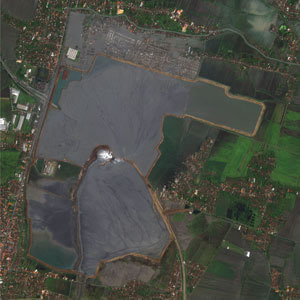|
NEWS NOTES
An unnatural disaster in Indonesia
 courtesy of Durham University |
| Mud from the Lusi mud volcano has buried more than 10 square kilometers and a dozen villages, as shown in this satellite photo. |
Two years after a mysterious mud volcano sprang up overnight in East Java, Indonesia, an international team of scientists has ruled out all possible natural causes and concluded that a nearby gas drilling operation is to blame for triggering the eruption.
On May 28, 2006, Lapindo Brantas, an Indonesian oil and gas company, was drilling an exploratory well near the town of Sidoarjo. The following day, a mixture of hot water and muck began spewing out of the ground 200 meters away from the new well. Lapindo denied the well was the cause; it blamed a magnitude-6.3 earthquake that occurred 250 kilometers away two days before the muddy eruption began.
To date, the mudflow, called Lusi by locals, has burped out more than 75 billion cubic meters of hot, noxious mud. The mudflow has buried a dozen villages under as much as 20 meters of ooze, displaced 30,000 residents and killed 13 people, with no end to the eruption in sight.
But while the eruption is certainly a major disaster, it also affords scientists a rare opportunity to study the birth and evolution of a mud volcano, says Richard Davies of Durham University’s Center for Research into Earth Energy Systems in the United Kingdom. The research possibilities are endless, he says, but with millions of dollars in potential damages at stake, Davies and his colleagues decided first to determine whether the Java disaster was natural or caused by humans.
Maria Brumm, a graduate student at the University of California at Berkeley, and Michael Manga, a geologist at Berkeley, examined underground pressure changes produced by the quake, but found them to be negligible. Thus, although “earthquakes can trigger volcanoes, in this case, the earthquake was simply too small and too far away,” Manga says. Davies then scoured Lapindo operational documents to see what the company might have done to induce the mudflow. It turns out that “the day before the mud volcano started there was a huge ‘kick’ in the well, which is an influx of fluid and gas into the wellbore,” Davies says. The drill hit a high-pressure aquifer. Water, gases and dirt shot to the surface, he says, and the Lusi mud volcano was born.
Davies and his colleagues published their findings in June’s Earth and Planetary Science Letters, perhaps giving the Indonesian government the ammunition it needs to pursue litigation against Lapindo Brantas. “The science is crisp and clear,” Davies says. Experts working for Lapindo still blame the earthquake and several independent scientists remain skeptical, however. “Davies’ results provide one interpretation of the drilling data,” says Adriano Mazzini of the University of Oslo in Norway. “Other engineers give other interpretations. Our results and simulations show that the cause is natural and that the trigger is also natural,” Mazzini says. Davies will face off against experts working for Lapindo at a public debate in October.
 Adriano Mazzini |
| Lusi continues to spew more than 100,000 cubic meters of mud a day, enough to fill 53 Olympic swimming pools. |
Meanwhile, Lusi continues to spew more than 100,000 cubic meters of mud each day and the surrounding land is sinking rapidly — as much as three meters a day — under the weight. Davies suspects a bowl-like caldera is forming right before his eyes, the first time scientists have ever observed such a phenomenon in real time.
Davies still hopes to determine how long Lusi will remain active by measuring the size and pressure of the aquifer feeding the volcano. “Some mud volcanoes have been active for thousands of years,” he says. “But no matter what, even if Lusi stops tomorrow, this region is probably going to be a total loss.”

 Subscribe
Subscribe


